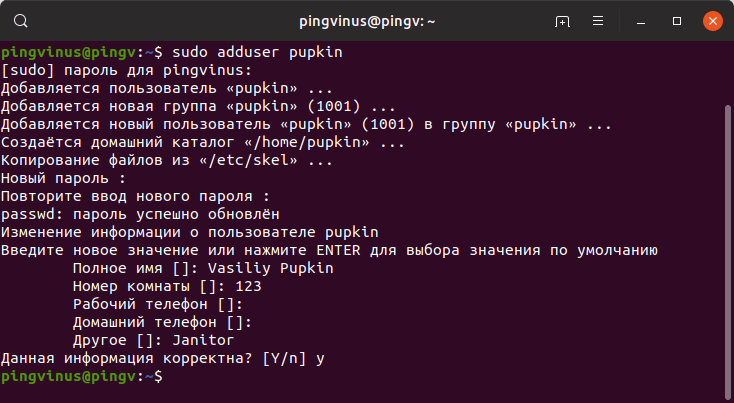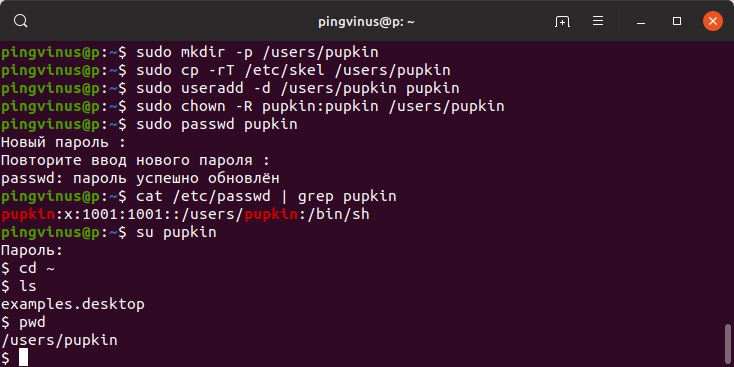- Создание пользователя в Linux. Команды adduser и useradd
- В чем отличия adduser и useradd?
- Команда adduser
- Создание пользователя командой adduser
- Команда useradd
- Синтаксис команды useradd
- Создание нового пользователя
- Создание нового пользователя с домашней директорией в /home
- Создание нового пользователя с произвольной домашней директорией
- Создание нового пользователя с произвольными UID, GID
- Создание пользователя с указанием оболочки (shell)
- Создать пользователя и добавить его в группы
- Заключение
- The Complete Guide to “useradd” Command in Linux – 15 Practical Examples
- Useradd Command Syntax
- 1. How to Add a New User in Linux
- 2. Create a User with Different Home Directory
- 3. Create a User with a Specific User ID
- 4. Create a User with a Specific Group ID
- 5. Add a User to Multiple Groups
- 6. Add a User without Home Directory
- 7. Create a User with Account Expiry Date
- 8. Create a User with Password Expiry Date
- 9. Add a User with Custom Comments
- 10. Create User Login Shell in Linux
- 11. Add a User with Specific Home Directory, Default Shell, and Custom Comment
- 12. Add a User with Home Directory, Custom Shell, Custom Comment, and UID/GID
- 13. Add a User with Home Directory, No Shell, Custom Comment, and User ID
- 14. Add a User with Home Directory, Shell, Custom Skell/Comment, and User ID
- 15. Add a User without Home Directory, No Shell, No Group, and Custom Comment
- If You Appreciate What We Do Here On TecMint, You Should Consider:
Создание пользователя в Linux. Команды adduser и useradd
Для создания пользователей в Linux можно использовать графические утилиты, предоставляемые дистрибутивом, или воспользоваться командной строкой.
Для создания пользователей из командной строки обычно используют утилиты adduser или useradd. Рассмотрим, использование данных утилит.
В чем отличия adduser и useradd?
useradd — это низкоуровневая утилита для создания пользователей в Linux.
adduser — представляет собой более простое решение для создания пользователей и по факту является надстройкой над useradd, groupadd и usermod.
Утилита adduser доступна не во всех дистрибутивах Linux. Реализация adduser также может отличаться. Если в дистрибутиве присутствует утилита adduser, то для создания пользователей рекомендуется использовать именно ее.
Команда adduser
Создание пользователя командой adduser
Рассмотрим, как создать обычного пользователя командой adduser
Чтобы создать нового пользователя, выполняем команду adduser и указываем имя пользователя (вместо pupkin укажите имя пользователя, которого вы создаете):
После запуска данной команды, вы должны ввести пароль для нового пользователя. Затем будет предложено ввести дополнительную информацию о пользователе: имя, номер комнаты (кабинета), телефоны и комментарий. Вводить эту информацию необязательно. Просто нажимайте Enter , чтобы пропустить ввод данных.
В результате выполнения команды adduser будут выполнены следующие действия:
- Создается новый пользователь с именем, которое вы указали при выполнении команды.
- Создается группа с тем же именем.
- Создается домашний каталог пользователя в директории /home/имяпользователя
- В домашний каталог копируются файлы из директории /etc/skel
В данной директории хранятся файлы, которые копируются в домашний каталог всех новых пользователей.
Команда useradd
Синтаксис команды useradd
Команда useradd принимает в качестве аргумента имя пользователя, а также различные опции.
Синтаксис команды следующий:
Создание нового пользователя
Чтобы просто создать пользователя используется команда useradd без каких-либо опций. Указывается только имя пользователя.
Данная команда создает нового пользователя с системными параметрами по умолчанию, которые прописаны в файле /etc/default/useradd
Чтобы пользователь мог войти в систему, необходимо задать для него пароль. Для этого используем команду:
Создание нового пользователя с домашней директорией в /home
Создадим пользователя и его домашнюю директорию.
Домашняя директория создается по умолчанию в каталоге /home . Имя директории совпадает с именем пользователя.
Создание нового пользователя с произвольной домашней директорией
Чтобы создать пользователя с домашней директорией, расположенной в произвольном месте, используется опция -d , после которой указывается путь до директории. Директорию необходимо создать заранее.
Создаем домашнюю директорию для будущего пользователя:
Копируем файлы и директории, которые по умолчанию создаются в домашней директории пользователя в данной системе. Данные файлы находятся в директории /etc/skel
Создаем пользователя и указываем домашнюю директорию:
Меняем права доступа у домашней директории:
Задаем пароль для пользователя:
Можно просмотреть информацию о пользователе, которая сохранена в файле /etc/passwd
Создание нового пользователя с произвольными UID, GID
Каждый пользователь в Linux имеет свой числовой идентификатор — UID, а также идентификатор основной группы пользователя — GID.
При создании пользователя можно задать произвольные номера UID и/или GID. При указании номера группы, группа с этим номером должна быть создана заранее.
Создание пользователя с указанием оболочки (shell)
По умолчанию новые пользователи создаются с оболочкой /bin/sh Чтобы задать другую оболочку, используется опция -s /путь/до/оболочки
Создать пользователя и добавить его в группы
Обычно пользователи в Linux принадлежат нескольким группам. Чтобы при создании нового пользователя задать группы, к которым он будет принадлежать, используется опция -G список,групп
Заключение
Мы рассмотрели примеры создания нового пользователя в Linux с использованием команд adduser и useradd . Команда adduser более простая и в большинстве случаев рекомендуется использовать именно ее.
Источник
The Complete Guide to “useradd” Command in Linux – 15 Practical Examples
We all are aware of the most popular command called ‘useradd‘ or ‘adduser‘ in Linux. There are times when a Linux System Administrator is asked to create user accounts on Linux with some specific properties, limitations, or comments.
In Linux, a ‘useradd‘ command is a low-level utility that is used for adding/creating user accounts in Linux and other Unix-like operating systems. The ‘adduser‘ is much similar to the useradd command because it is just a symbolic link to it.

In some other Linux distributions, the useradd command may come with a slightly different version. I suggest you read your documentation, before using our instructions to create new user accounts in Linux.
When we run the ‘useradd‘ command in the Linux terminal, it performs the following major things:
- It edits /etc/passwd, /etc/shadow, /etc/group and /etc/gshadow files for the newly created user accounts.
- Creates and populates a home directory for the new user.
- Sets permissions and ownerships to the home directory.
Useradd Command Syntax
The Basic syntax of the useradd command is:
In this article, we will show you the most used 15 useradd commands with their practical examples in Linux. We have divided the section into two parts from Basic to Advance usage of the command.
- Part I: Basic Useradd Commands with 10 examples
- Part II: Advance Useradd Commands with 5 examples
1. How to Add a New User in Linux
To add/create a new user, you’ve to follow the command ‘useradd‘ or ‘adduser‘ with ‘username‘. The ‘username‘ is a user login name, that is used by a user to login into the system.
Only one user can be added and that username must be unique (different from other usernames already exists on the system).
For example, to add a new user called ‘tecmint‘, use the following command.
When we add a new user in Linux with the ‘useradd‘ command it gets created in a locked state and to unlock that user account, we need to set a password for that account with the ‘passwd‘ command.

Once a new user is created, its entry is automatically added to the ‘/etc/passwd‘ file. The file is used to store the user’s information and the entry should be.

The above entry contains a set of seven colon-separated fields, each field has its own meaning. Let’s see what are these fields:
- Username: User login name used to login into the system. It should be between 1 to 32 characters long.
- Password: User password (or x character) stored in /etc/shadow file in encrypted format.
- User ID (UID): Every user must have a User ID (UID) User Identification Number. By default, UID 0 is reserved for the root user and UID’s ranging from 1-99 are reserved for other predefined accounts. Further UID’s ranging from 100-999 are reserved for system accounts and groups.
- Group ID (GID): The primary Group ID (GID) Group Identification Number stored in the /etc/group file.
- User Info: This field is optional and allows you to define extra information about the user. For example, user full name. This field is filled by the ‘finger’ command.
- Home Directory: The absolute location of the user’s home directory.
- Shell: The absolute location of a user’s shell i.e. /bin/bash.
2. Create a User with Different Home Directory
By default ‘useradd‘ command creates a user’s home directory under /home directory with a username. Thus, for example, we’ve seen above the default home directory for the user ‘tecmint‘ is ‘/home/tecmint‘.
However, this action can be changed by using the ‘-d‘ option along with the location of the new home directory (i.e. /data/projects). For example, the following command will create a user ‘anusha‘ with a home directory ‘/data/projects‘.
You can see the user home directory and other user-related information like user id, group id, shell, and comments.

3. Create a User with a Specific User ID
In Linux, every user has its own UID (Unique Identification Number). By default, whenever we create a new user account in Linux, it assigns userid 500, 501, 502, and so on…
But, we can create users with custom userid with the ‘-u‘ option. For example, the following command will create a user ‘navin‘ with custom userid ‘1002‘.
Now, let’s verify that the user created with a defined userid (1002) using the following command.

NOTE: Make sure the value of a user ID must be unique from any other already created users on the system.
4. Create a User with a Specific Group ID
Similarly, every user has their own GID (Group Identifier). We can create users with specific group IDs as well with the -g option.
Here in this example, we will add a user ‘tarunika‘ with a specific UID and GID simultaneously with the help of ‘-u‘ and ‘-g‘ options.
Now, see the assigned user id and group id in ‘/etc/passwd‘ file.
To verify the user’s GID, use the id command:

5. Add a User to Multiple Groups
The ‘-G‘ option is used to add a user to additional groups. Each group name is separated by a comma, with no intervening spaces.
Here in this example, we are adding a user ‘tecmint‘ into multiple groups like admins, webadmin, and developer.
Next, verify that the multiple groups are assigned to the user with the id command.

6. Add a User without Home Directory
In some situations, where we don’t want to assign home directories for a user, due to some security reasons. In such a situation, when a user logs into a system that has just restarted, its home directory will be root. When such a user uses the su command, its login directory will be the previous user’s home directory.
To create users without their home directories, ‘-M‘ is used. For example, the following command will create a user ‘shilpi‘ without a home directory.
Now, let’s verify that the user is created without a home directory, using the ls command.

7. Create a User with Account Expiry Date
By default, when we add user’s with the ‘useradd‘ command user account never get expires i.e their expiry date is set to 0 (means never expired).
However, we can set the expiry date using the ‘-e‘ option, which sets the date in YYYY-MM-DD format. This is helpful for creating temporary accounts for a specific period of time.
Here in this example, we create a user ‘aparna‘ with account expiry date i.e. 27th August 2021 in YYYY-MM-DD format.
Next, verify the age of the account and password with the ‘chage‘ command for user ‘aparna‘ after setting the account expiry date.

8. Create a User with Password Expiry Date
The ‘-f‘ argument is used to define the number of days after a password expires. A value of 0 inactive the user account as soon as the password has expired. By default, the password expiry value set to -1 means never expire.
Here in this example, we will set an account password expiry date i.e. 45 days on a user ‘mansi‘ using ‘-e‘ and ‘-f‘ options.

9. Add a User with Custom Comments
The ‘-c‘ option allows you to add custom comments, such as the user’s full name, phone number, etc to /etc/passwd file. The comment can be added as a single line without any spaces.
For example, the following command will add a user ‘mansi‘ and would insert that user’s full name, Manis Khurana, into the comment field.
You can see your comments in the ‘/etc/passwd‘ file in the comments section.

10. Create User Login Shell in Linux
Sometimes, we add users who have nothing to do with the login shell or sometimes we require to assign different shells to our users. We can assign different login shells to each user with the ‘-s‘ option.
Here in this example, will add a user ‘tecmint‘ without login shell i.e. ‘/sbin/nologin‘ shell.
You can check the assigned shell to the user in the ‘/etc/passwd‘ file.

11. Add a User with Specific Home Directory, Default Shell, and Custom Comment
The following command will create a user ‘ravi‘ with home directory ‘/var/www/tecmint‘, default shell /bin/bash and adds extra information about the user.

In the above command ‘-m -d‘ option creates a user with a specified home directory and the ‘-s‘ option sets the user’s default shell i.e. /bin/bash. The ‘-c‘ option adds the extra information about the user and the ‘-U‘ argument creates/adds a group with the same name as the user.
12. Add a User with Home Directory, Custom Shell, Custom Comment, and UID/GID
The command is very similar to above, but here we defining shell as ‘/bin/zsh‘ and custom UID and GID to a user ‘tarunika‘. Where ‘-u‘ defines the new user’s UID (i.e. 100) and whereas ‘-g‘ defines GID (i.e. 1000).

13. Add a User with Home Directory, No Shell, Custom Comment, and User ID
The following command is very much similar to the above two commands, the only difference is here, that we disabling the login shell to a user called ‘avishek‘ with a custom User ID (i.e. 1019).
Here ‘-s‘ option adds the default shell /bin/bash, but in this case we set login to ‘/usr/sbin/nologin‘. That means user ‘avishek‘ will not able to login into the system.

14. Add a User with Home Directory, Shell, Custom Skell/Comment, and User ID
The only change in this command is, we used ‘-k‘ option to set the custom skeleton directory i.e. /etc/custom.skell, not the default one /etc/skel. We also used ‘-s‘ option to define different shell i.e. /bin/tcsh to user ‘navin‘.

15. Add a User without Home Directory, No Shell, No Group, and Custom Comment
The following command is very different than the other commands explained above. Here we used the ‘-M‘ option to create a user without the user’s home directory and the ‘-N‘ argument is used that tells the system to only create a username (without group). The ‘-r‘ argument is for creating a system user.

For more information and options about useradd, run the ‘useradd‘ command on the terminal to see available options.
If You Appreciate What We Do Here On TecMint, You Should Consider:
TecMint is the fastest growing and most trusted community site for any kind of Linux Articles, Guides and Books on the web. Millions of people visit TecMint! to search or browse the thousands of published articles available FREELY to all.
If you like what you are reading, please consider buying us a coffee ( or 2 ) as a token of appreciation.
We are thankful for your never ending support.
Источник







